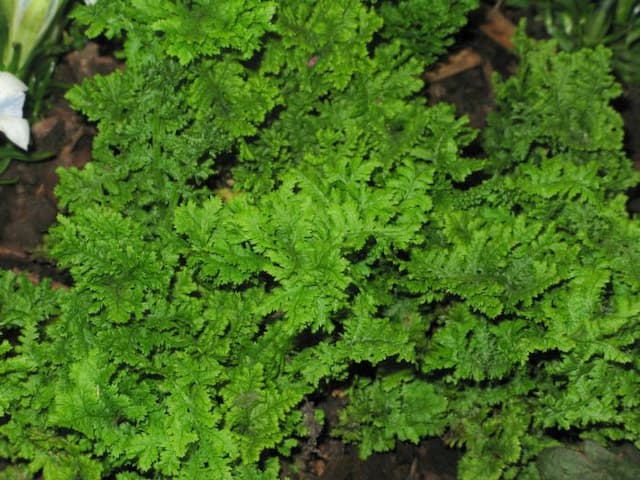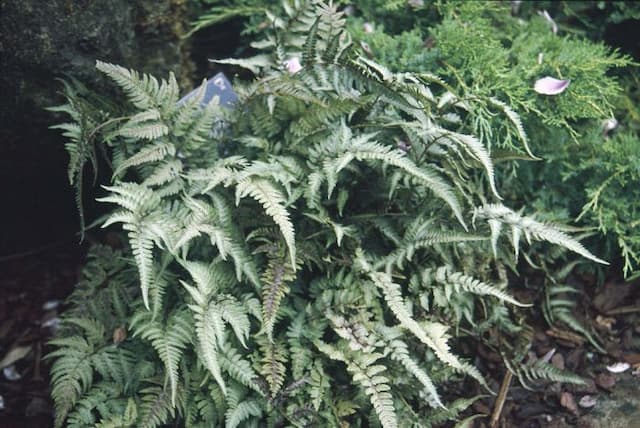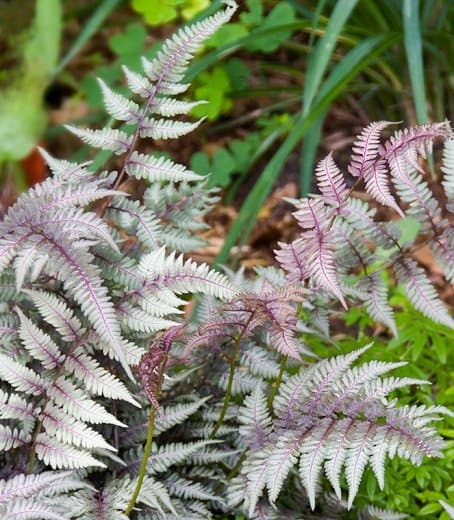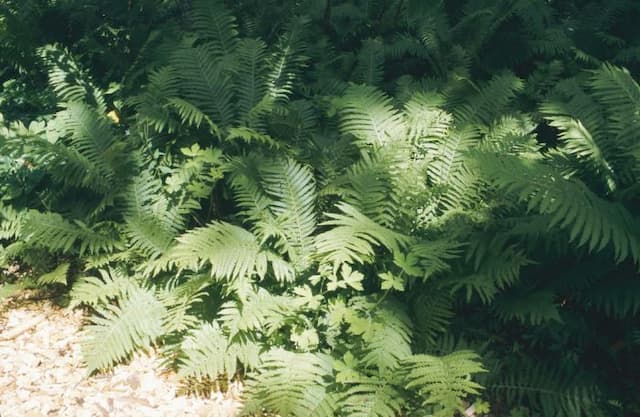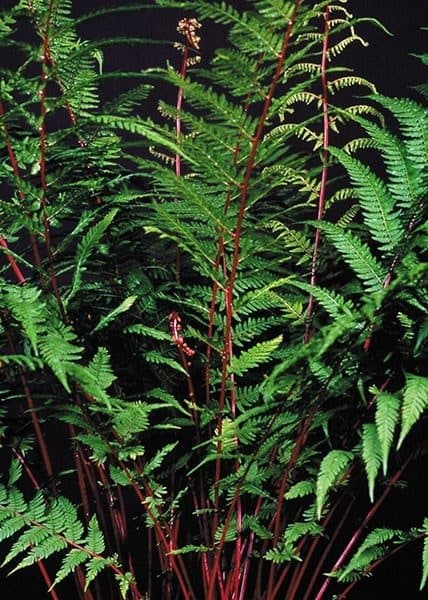Athyrium filix-femina 'Frizelliae'

ABOUT
The Athyrium filix-femina 'Frizelliae', commonly known as the Tatting Fern, has a distinctive and delicate appearance. The fronds of this fern are unique, characterized by their fine texture and unusual structure. Each frond carries a series of small, rounded leaflets, which are arrayed tightly along the central stem. These leaflets have an enchanting, beadlike quality, as if they were carefully strung together by an artisan. The overall visual effect is reminiscent of lace tatting, hence the common name. The delicate leaflets form a narrow, tapering shape along the frond, creating an elegant and feathery appearance. The Tatting Fern displays a fresh, vibrant green color that can provide a soft, airy element to any shade garden or as an accent in a woodland setting. The slender and arching fronds add a textural contrast when planted among plants with broader leaves. As a fern, it belongs to a group of plants known for their ability to thrive in moist, shaded environments, and the Tatting Fern is no exception. It prefers areas where it can be sheltered from direct sunlight, enjoying the dappled light beneath larger plants or trees. It typically displays the lush, verdant growth that is characteristic of ferns in general, contributing to its overall elegant and whimsical look.
About this plant
 Names
NamesFamily
Athyriaceae
Synonyms
Tatting Fern, Frizelliae Lady Fern
Common names
Athyrium filix-femina 'Frizelliae'.
 Toxicity
ToxicityTo humans
The most common common name for Athyrium filix-femina 'Frizelliae' is Lady Fern. Lady Fern is generally considered non-toxic to humans. There are no well-documented cases of poisoning from ingesting this plant, and it is not typically associated with adverse effects if accidentally consumed.
To pets
Lady Fern, the common name for Athyrium filix-femina 'Frizelliae', is also considered non-toxic to pets. It does not contain any known compounds that are harmful to animals, so ingestion by pets such as cats and dogs is unlikely to cause poisoning or serious health issues.
 Characteristics
CharacteristicsLife cycle
Perennials
Foliage type
Deciduous
Color of leaves
Green
Height
1-3 feet (30-90 cm)
Spread
1-2 feet (30-60 cm)
Plant type
Fern
Hardiness zones
4-8
Native area
Europe Asia
Benefits
 General Benefits
General Benefits- Aesthetic Appeal: The unique frond structure of the Tatting Fern offers an ornamental look to any garden or shaded area.
- Shade Tolerance: This plant thrives in shady conditions, making it ideal for woodland gardens or shaded borders.
- Low Maintenance: As a hardy fern, it requires minimal care once established, requiring only consistent moisture and occasional pruning.
- Soil Erosion Control: The fern helps to prevent soil erosion in sloped or uneven garden areas, thanks to its spreading nature.
- Habitat Creation: Tatting Fern provides shelter and habitat for various species of wildlife, including insects and birds.
- Seasonal Interest: It adds greenery throughout the spring, summer, and fall, dying back in winter before re-emerging.
- Non-Invasive: Unlike some other ferns, the Tatting Fern is non-invasive and will not spread uncontrollably in the garden.
 Medical Properties
Medical PropertiesThis plant is not used for medical purposes.
 Air-purifying Qualities
Air-purifying QualitiesThis plant is not specifically known for air purifying qualities.
 Other Uses
Other Uses- The 'Frizelliae' variety of lady fern can be used in floral arrangements to add texture and visual interest with its delicate, intricate leaves.
- Pressed lady fern leaves from this cultivar can be used in botanical art projects, including card making or decorative picture frames.
- In a terrarium or fairy garden, lady fern can provide a lush, miniature forest backdrop, enhancing the magical aesthetic of the miniature landscapes.
- Some gardeners use the distinct fronds of lady fern as stencils for garden path designs or creative outdoor art projects.
- The plant’s unique foliage can serve as a natural dye source, offering a range of green hues to textiles or craft papers.
- Creative chefs might use the sterilized fronds as an aesthetic garnish for plating high-end dishes, particularly in forest-themed cuisine.
- In photography, the intricate frond patterns of lady fern can be used as subjects for macro photography to showcase natural symmetry and fractal patterns.
- During nature-inspired educational activities, children can use the fern leaves for leaf rubbing activities to learn about plant textures and vein structures.
- As an addition to a bridal bouquet, the whimsical fronds can add a touch of woodland charm and uniqueness to the arrangement.
- Lady fern can be included in a natural compost mix, providing important nutrients and fostering beneficial microbial activity as it decomposes.
Interesting Facts
 Feng Shui
Feng ShuiThe Lady Fern is not used in Feng Shui practice.
 Zodiac Sign Compitability
Zodiac Sign CompitabilityThe Lady Fern is not used in astrology practice.
 Plant Symbolism
Plant Symbolism- Femininity: The common name of Athyrium filix-femina 'Frizelliae' is Lady Fern, and it symbolizes feminine grace and delicacy, reflecting the dainty and intricate nature of its fronds.
- Discretion: Despite its charm, the Lady Fern grows in subtle, understated environments, leading to its association with discretion and modesty.
- New Beginnings: The unfurling of the fern's fronds in spring represents new beginnings and the start of new ventures.
- Solitude: As a plant often found in quiet, shady spots, the Lady Fern can signify a love of solitude and the peacefulness found in one's own company.
- Shelter: The canopy of fronds provides a microhabitat for small creatures, which is why the Lady Fern can be a symbol of protection and shelter.
- Eternal Youth: Lady Ferns can live for a very long time and maintain their lush appearance, symbolizing eternal youth and vigor.
 Water
WaterThe plant commonly known as 'Tatting Fern' prefers consistently moist soil but not waterlogged conditions. It is best to water the plant deeply when the top inch of the soil feels dry to the touch. This might equate to watering once or twice a week, depending on the climate and indoor conditions. Ensure that the soil has adequate drainage to prevent root rot. Typically, for an average-sized plant, watering with approximately 16-24 ounces of water should suffice each time you water. Adjust the amount depending on the size of the plant and the environmental conditions.
 Light
LightThe 'Tatting Fern' thrives best in partial to full shade environments. It should be positioned in a spot where it receives filtered light or only a few hours of morning sunlight, as intense direct sunlight can scorch the delicate fronds. A north-facing window or a location under the canopy of larger plants or trees is ideal for ensuring the right light conditions.
 Temperature
Temperature'Tatting Fern' prefers a temperature range between 55° and 75°F. It can tolerate temperature dips down to around 40°F but cold temperatures below this can be harmful to the plant. Ideally, keep it in a location where it can enjoy the cooler end of its preferred temperature spectrum for optimal growth.
 Pruning
PruningPruning 'Tatting Fern' is primarily for removing any dead or damaged fronds to maintain its aesthetic appeal and overall health. This can be done as needed throughout the year. The best time for more extensive pruning is in late winter or early spring before new growth begins. This is also an ideal time to remove any old foliage to allow room for the new fronds to emerge.
 Cleaning
CleaningAs needed
 Soil
SoilThe Tatting Fern prefers a soil mix that is rich in organic matter with good drainage and a slightly acidic to neutral pH between 5.0 and 7.0. A good recipe is one part garden soil, one part peat moss or coconut coir, and one part perlite or sand.
 Repotting
RepottingThe Tatting Fern does not require frequent repotting and can be done every 2-3 years or when it outgrows its container. Best done in spring.
 Humidity & Misting
Humidity & MistingTatting Fern thrives in high humidity conditions, ideally between 60-80%. It's important to maintain consistent humidity for optimal growth.
 Suitable locations
Suitable locationsIndoor
Place in bright, indirect light with high humidity.
Outdoor
Grow in filtered light, moist soil, and protect from harsh sun.
Hardiness zone
4-9 USDA
 Life cycle
Life cycleThe Lady Fern 'Frizelliae', also known as Athyrium filix-femina 'Frizelliae', begins its life cycle with the germination of spores, which typically occurs in damp, shaded environments. The germinating spores give rise to a gametophyte, a small heart-shaped prothallus that contains both male and female reproductive organs. Following fertilization, the sporophyte emerges, developing into a young fern with curled fronds that gradually uncurl in a process called circinate vernation. As the plant matures, it forms distinctive fronds with a unique 'beaded' appearance due to the pinnae being reduced to small, rounded lobes. The mature Lady Fern will spread slowly through rhizomes and can reach a height of 18-24 inches. During its reproductive phase, sporangia develop on the undersides of the fronds, and when mature, they release spores to continue the life cycle.
 Propogation
PropogationPropogation time
Spring-summer
Propogation: The most popular method of propagating the Lady fern 'Frizelliae', a variant of Athyrium filix-femina, is by division. The ideal time to propagate by division is in the early spring as the new fronds begin to emerge. To propagate, dig up the parent plant carefully, ensuring a good amount of roots and crowns are intact. Then, using a sharp knife or spade, divide the clump into smaller sections, each with at least one growing point or crown. Replant the divisions immediately, at the same depth they were growing before, and water them thoroughly. It's essential to keep the soil moist until the new plants are established. This asexual method ensures that the distinctive features of 'Frizelliae' are retained in the offspring.
